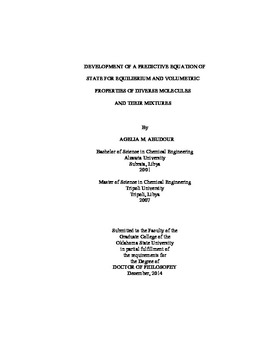| dc.contributor.advisor | Gasem, Khaled A. M. | |
| dc.contributor.author | Abudour, Agelia M. | |
| dc.date.accessioned | 2016-01-20T15:44:21Z | |
| dc.date.available | 2016-01-20T15:44:21Z | |
| dc.date.issued | 2014-12 | |
| dc.identifier.uri | https://hdl.handle.net/11244/25625 | |
| dc.description.abstract | Accurate prediction of the phase equilibrium and volumetric properties of pure fluids and their mixtures is essential for chemical process design and related applications. Although experiments provide accurate data at specific phase conditions, such data are limited and do not meet the ever-expanding industrial needs for process design and development. Therefore, a need exists for models that can provide accurate predictions of a wide range of thermodynamic properties. | |
| dc.description.abstract | Cubic equations of state (CEOS) are widely used for calculations of thermodynamic properties; however, they often require experimental data for system-specific model tuning. An attractive alternative is to develop predictive equations of state that can estimate these properties based solely on the molecular structure - the most basic information that is generally available. In this work, the Peng-Robinson (PR) EOS is the focus of such development. | |
| dc.description.abstract | The two main objectives of this study are to (1) develop improved generalized models for critical properties, acentric factor and vapor-liquid equilibria (VLE) property predictions using a theory-framed quantitative structure-property relationship (QSPR) modeling approach and (2) develop a new volume-translation function with a scaling-law correction to predict liquid density for pure fluids and mixtures of diverse molecules. | |
| dc.description.abstract | To facilitate model development, a comprehensive databases of experimental measurements was assembled for pure-fluid critical properties, acentric factors, and liquid densities as well as VLE and liquid densities of binary mixtures. QSPR models were then developed to provide a priori predictions for the critical properties, acentric factor and VLE properties. The newly developed QSPR models for the critical properties provided predictions within twice the experimental errors. Similarly for VLE predictions, the QSPR models resulted in approximately twice the errors obtained through the data regression analyses of the VLE systems considered. Also, a new volume-translation method for the PR EOS was developed. The volume-translation function parameter was generalized in terms of molecular properties of each fluid. Then, the volume-translated PR EOS was extended to predict liquid densities of diverse mixtures employing EOS conventional mixing rules. The volume-translation approach developed in this work has been shown capable of providing accurate predictions of liquid densities in the saturated as well as single-phase regions for pure fluids and mixtures over large ranges of pressure and temperature. Specifically, the new volume-translated PR EOS yielded errors that are three to six times lower than the corresponding predictions from the untranslated model. | |
| dc.format | application/pdf | |
| dc.language | en_US | |
| dc.rights | Copyright is held by the author who has granted the Oklahoma State University Library the non-exclusive right to share this material in its institutional repository. Contact Digital Library Services at lib-dls@okstate.edu or 405-744-9161 for the permission policy on the use, reproduction or distribution of this material. | |
| dc.title | Development of a predictive equation of state for equilibrium and volumetric properties of diverse molecules and their mixtures | |
| dc.contributor.committeeMember | Robinson, Robert L., Jr. | |
| dc.contributor.committeeMember | Ramsey, Josh D. | |
| dc.contributor.committeeMember | Hagan, Martin | |
| osu.filename | Abudour_okstate_0664D_13730.pdf | |
| osu.accesstype | Open Access | |
| dc.type.genre | Dissertation | |
| dc.type.material | Text | |
| thesis.degree.discipline | Chemical Engineering | |
| thesis.degree.grantor | Oklahoma State University | |
